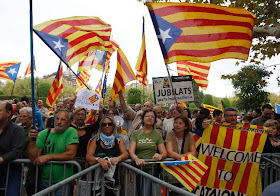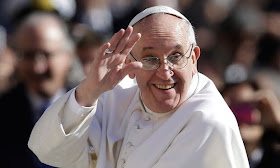 |
| The eight core secessionist counties in Colorado in red, and two that are thinking about it in yellow |
Last year, in the wake of
Barack Obama’s reelection, politically conservative Americans were showing their outrage by flooding the White House’s “We the People” petition web-page with demands for each of the 50 states to secede from the
United States (as reported
at the time in this blog (
and in a follow-up)). (There was a racial component to this: the vast majority of secession demands came from the Old
Confederacy.) This year’s Tea Party symbolic-protest theme is 51st-state movements. In addition to the existing pushes for
statehood for an Orange County–based South California and
a Chicago-less and largely-white Rest-of-Illinois, and in addition to a Democratic statehood push in
District of Columbia and
a mostly-nonpartisan one in Puerto Rico, 2013 has seen:
a revival of the State of Jefferson idea in far-northern California and, most notably,
a high-profile push for a State of Northern Colorado. Now, the sparsely-populated western, Appalachian counties of
Maryland want statehood too.
 |
| State of Jefferson supporters in northern California |
But, wait—is it really just symbolic politics? In
Colorado at least, maybe not: the question of getting out from under the yoke of the liberal oppressors in Denver and Boulder is now going to be on the ballot in nine counties [actually, 11; see below] this November.
 |
| Nice logo—too bad nearly all the actual grizzlies in the area referred to have been killed. |
In northeastern Colorado, the question of whether to form a
State of North Colorado (or Northern Colorado, or
New Colorado) will be put to voters in
Cheyenne,
Kit Carson,
Logan,
Phillips,
Sedgwick,
Washington,
Weld, and
Yuma counties, forming the rectangular state’s northeastern corner. The slightly discontiguous
Elbert County slipped in under the deadline, and it will be on the ballot there too. (
Morgan County decided to keep the question off the ballot, while
Lincoln and
Cheyenne counties also decided to sit this one out, after toying with the idea. [Since this article was written, Lincoln County
has reversed course and joined the other nine counties, and Moffatt County, in the northwest of the state,
has joined as well.]) There has even been interest in a merger coming out of adjoining rural disaffected areas in
Wyoming,
Nebraska, and
Kansas.
The insurgency started in Weld County, which includes the
University of Northern Colorado, in Greeley, but also includes rural voters fed up with environmental regulation, gun control, and now legal marijuana in an increasingly urban and liberal state that used to be a swing state. The eight core secessionist states had been getting support from other rural counties, not all of them in the northeast, but on August 27th commissioners of the separatist counties
met with their counterparts in Las Animas and Herfano counties, in the south of the state, along the border with
New Mexico.
 |
| One proposal for a North Colorado flag |
Mack Louden, commissioner of Las Animas County, told media, “There’s a lot of frustration in rural Colorado—east to west, north to south—about how we’re being treated. We own 90% of the land mass, but we represent a very small part of the population. All the votes are in Denver. They’ve figured that out and don’t worry too much about rural Colorado.”
Tom Gilley, president of the Weld County–based organization
51st State Initiative, said that commissioners in Las Animas and Herfano might bring the question to voters too. It wouldn’t be in time for the November 5th ballot, but it raises longer-term questions of just how, geographically, “New Colorado” (as they would now have to finally settle on calling it) would look.
 |
As you might imagine, the parking lots at Boulder’s University of Colorado
have very few pick-up trucks with gun racks and fetus bumper stickers. |
Louden added, “Right now, [secession] looks very appealing on the surface. But once you start picking that scab down, you can get into some flesh that you don’t want to see.” Perhaps one of the things he means is that any new admissions to the Union need to be cleared not only by the state legislature in Denver but by Capitol Hill in Washington. And, with both houses of Congress being as evenly divided as they are, any new “red state” (i.e., one with two new
Republican senators) would need to be balanced out by a blue (
Democratic) one. This is an old tradition in American expansion. The
Missouri Compromise of 1820 allowed
Maine, a free state, and Missouri, a slave one, to balance each other out, while Republican
Alaska and Democratic
Hawaii had to be let in pretty much in tandem in 1959. And even if someone could craft, say, a D.C.-statehood bill to balance a “New Colorado” one, that still doesn’t mean that doesn’t mean it would be a sure thing.
... and now Maryland
 |
A possible proposal for a State of Western Maryland.
The current movement also includes Carroll County,
even though parts of it are almost suburban Baltimore. |
Such considerations may not be dampening enthusiasm in western Maryland’s mountainous conservative far-west, where the idea of statehood has recently caught on as well. Some residents in the Appalachian “panhandle” along the
Pennsylvania border, are interested in seceding from the rest of the very-blue State of Maryland.
Scott Strzelczyk, who lives in New Windsor, in Maryland’s
Carroll County, has
founded an organization called
Western Maryland: A New State Initiative. Strzelczyk is host of a local AM radio show with a dissident, “constitutionalist” bent called
The Forgotten Men. He envisions Western Maryland to consist of
Garrett,
Allegany,
Washington,
Frederick, and Carroll counties—all of them Republican counties with tiny populations forming a geographically eccentric protrusion westward from a coastal stated that has two Democratic senators in Washington, includes heavily African-American Baltimore and the liberal northern suburbs of D.C., and voted for Obama by almost 62% in both 2008 and 2012.
 |
Maryland’s counties, shown in shades of red or blue
based on their respective vote shares for Mitt Romney or Barack Obama, respectively, in 2012 |
Though far less organized and far less popular than the North Colorado movement, the idea of partitioning Maryland is not new. Its sprawling eastern leg is just as geographically anomalous as its western one, and just as divorced from the concerns of the bulk of the population in Baltimore, Annapolis, and the D.C. suburbs. This Eastern Shore region, along Chesapeake Bay, with its more Southern-style plantation culture and economy, used to be Maryland’s demographic and political anchor, until the rise of Baltimore in the 19th century. In 1998, the nine easternmost counties proposed seceding as a new state to be called either
Chesapeake,
Eastshore, or—getting poetic now—
Atlantis or
Arcadia. Others have wanted those nine counties to join
Delaware, along with
Virginia’s disconnected
Accomack and
Northampton counties, to form a
State of Delmarva, though that makes no political sense: why would the Democrats who run Delaware with little opposition want to dilute their power in a more purplish state?
Names from the 1998 Eastern Shore movement like
Chesapeake and
Arcadia point up a singular failing of some of today’s 51st-state movements: unimaginative names. The idea of Western Maryland would be much more likely to stir passions if it were called something like
Allegania or
Cumberland, while northeastern Colorado, though it has few remotely colorful county or town names, would benefit from being renamed something along the lines of
Northern Front Range, which is what locals call the region. The Platte River runs through the area, so maybe that could be used to form a name. Anything but
New Colorado or
North Colorado, though—if only because
North Carolina has already squatted on the postal abbreviation
NC.
 |
It seems unlikely Western Maryland would come up with a flag more impressive
than Maryland’s current one, based on the coat-of-arms of Lord Baltimore. |
[Also, for those who are wondering, yes, this blog is tied in with a forthcoming book, a sort of encyclopedic atlas to be published by Auslander and Fox under the title Let’s Split! A Complete Guide to Separatist Movements, Independence Struggles, Breakaway Republics, Rebel Provinces, Pseudostates, Puppet States, Tribal Fiefdoms, Micronations, and Do-It-Yourself Countries, from Chiapas to Chechnya and Tibet to Texas. Look for it some time in 2013. I will be keeping readers posted of further publication news.]



















































